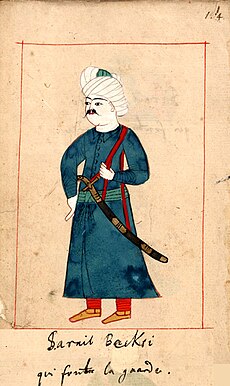
Back Ottomaanse Turke Afrikaans أتراك عثمانيون Arabic اتراك عثمانيين ARZ Туркал-гӀусманиял AV Osmanlı türkləri Azerbaijani Асманы Byelorussian Османски турци Bulgarian Osmanitürklased Estonian Turki Utsmani ID 오스만 튀르크인 Korean
Osmanlı Türkleri | |
|---|---|
 Painting of an Ottoman Turkish sipahi, 1657 | |
| Total population | |
| Regions with significant populations | |
| Languages | |
| Old Anatolian Turkish[note 4] Ottoman Turkish[note 5] | |
| Religion | |
| Sunni Islam (majority) Alevism (minority) | |
| Related ethnic groups | |
| Turkish people | |
|
The Ottoman Turks (Turkish: Osmanlı Türkleri) were a Turkic ethnic group. Originally from Central Asia, they migrated to Anatolia in the 13th century and founded the Ottoman Empire, in which they remained socio-politically dominant for the entirety of the six centuries that it existed. Their descendants are the present-day Turkish people, who comprise the majority of the population in the Republic of Turkey, which was established shortly after the end of World War I.
Reliable information about the early history of the Ottoman Turks remains scarce, but they take their Turkish name Osmanlı from Osman I, who founded the House of Osman alongside the Ottoman Empire; the name "Osman" was altered to "Ottoman" when it was transliterated into some European languages over time. The Ottoman principality, expanding from Söğüt, gradually began incorporating other Turkish-speaking Muslims and non-Turkish Christians into their realm. By the 1350s, they had begun crossing into Europe and eventually came to dominate the Mediterranean Sea. In 1453, the fall of Constantinople, which had served as the capital city of the Byzantine Empire, enabled the Ottoman Turks to control all major land routes between Asia and Europe. This development forced Western Europeans to find other ways to trade with Asians.[2][3][4] Following the dissolution of the Ottoman Empire, the Ottoman Turkish identity ceased to exist; the Ottoman Turkish language, which was written using the Perso-Arabic script, developed into the modern Latinized Turkish language.
- ^ Shaw, Stanford (1978). "The Ottoman Census System and Population, 1831-1914". Cambridge. JSTOR 162768.
- ^ Tolan, John; Veinstein, Gilles; Henry Laurens (2013). Europe and the Islamic World: A History. Princeton University Press. pp. 167–188. ISBN 978-0-691-14705-5.
- ^ İnalcık, Halil (1989). "Chapter VII. The Ottoman Turks and the Crusades, 1329-1451". In Zacour, N. P., and Hazard, H. W. (ed.). A History of the Crusades: Volume VI. The Impact of the Crusades on Europe. Madison: The University of Wisconsin Press. pp.175-221.
- ^ İnalcık, Halil (1989). "Chapter VII. The Ottoman Turks and the Crusades, 1451-1522". In Zacour, N. P., and Hazard, H. W. (ed.). A History of the Crusades: Volume VI. The Impact of the Crusades on Europe. Madison: The University of Wisconsin Press. pp. 311-353.
© MMXXIII Rich X Search. We shall prevail. All rights reserved. Rich X Search